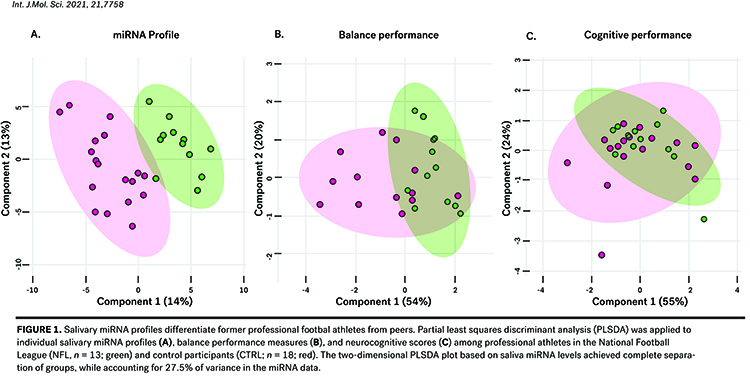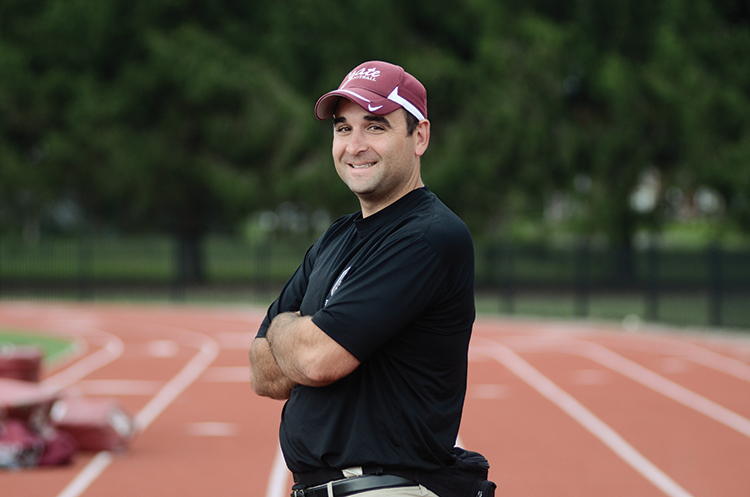Research leads to improvements in concussion diagnosis and treatment.
Can analysis of saliva help determine whether an athlete has had a concussion? It may be one forthcoming tool that can be used as part of a multimodal approach, according to Chuck Monteith, associate athletic trainer and concussion recovery manager at Colgate. He’s part of a research team — including doctors, neuroscientists, and exercise scientists from Penn State, Syracuse University, and other national institutions — that recently published its third paper based on a series of related studies.
The researchers examined salivary measurements of microribonucleic acids (miRNAs) for biomarkers of concussion. Monteith — who assisted with data collection, intake, and assessment — took cheek swabs from one of the two groups of participants. Their saliva was then analyzed at SUNY Upstate Medical University.
In the first group of participants, male former professional football athletes with a history of concussion were studied alongside a control group of age-matched peers (average age of the subjects was 73). Researchers found significant differences in salivary expression between the former professional athletes and control participants; three miRNAs demonstrated a potential physiologic relationship with prior concussion.
To determine whether those miRNAs could also be found in children and young adults, the researchers studied a second group, which included younger athletes with prior concussion. The participants were mostly male with varying concussion history and included some Colgate student-athletes who volunteered alongside students from eight other institutions. The student-athletes were compared to a control group of peers without prior concussion. Again, three miRNAs differentiated the participants who had and had not experienced concussion.
Monteith explains here how the findings could contribute to concussion diagnosis in the future and what that could mean for improving athletes’ recovery:
“No concussion is the same; concussions are individualized and so different with how people respond. We’re not trying to figure out one test; we’re trying to become more accurate in diagnosing.”
“It’s a multimodal approach to help with the assessment of concussion. It’s using a symptom checklist, balance and cognitive tests, and the saliva to help diagnose a concussion.”
“The goal is to have someone be able to go to an ER, where they could take a cheek swab and be able to help identify someone who has a concussion … then also identify who potentially could have chronic concussion symptoms.”
“The newest study is to help predict how long a recovery will be. Most [adults with] concussions recover within 10 to 14 days. But, if a person’s recovery is going to take longer than that, we could let them know what they can expect and it can maybe help decrease any anxiety or depression from having these injuries.”
“Currently, using saliva is not something that we do [at Colgate]. It’s too new. Potentially, it would be nice to be able to do this on a sideline. But, there are different biomarkers that could be utilized to help diagnose; some show up immediately, and some show up days or weeks later. That’s the trickiness.”
“Almost four years ago, Colgate decided to put an emphasis on trying to have a more cohesive approach with concussions. Currently, first-year student-athletes complete education on concussions and baseline testing that entails balance, cognitive, and memory assessments. Then, we repeat yearly education and baseline assessments.”
“If a student-athlete sustains a concussion, I help them go through their recovery phases. Using their baseline scores, I reassess them and do a symptom checklist. I do an eye and inner ear test, then we do a balance and cognitive assessment. Based on their scores and symptoms, I walk them through the recovery process. It’s an individualized approach.”


